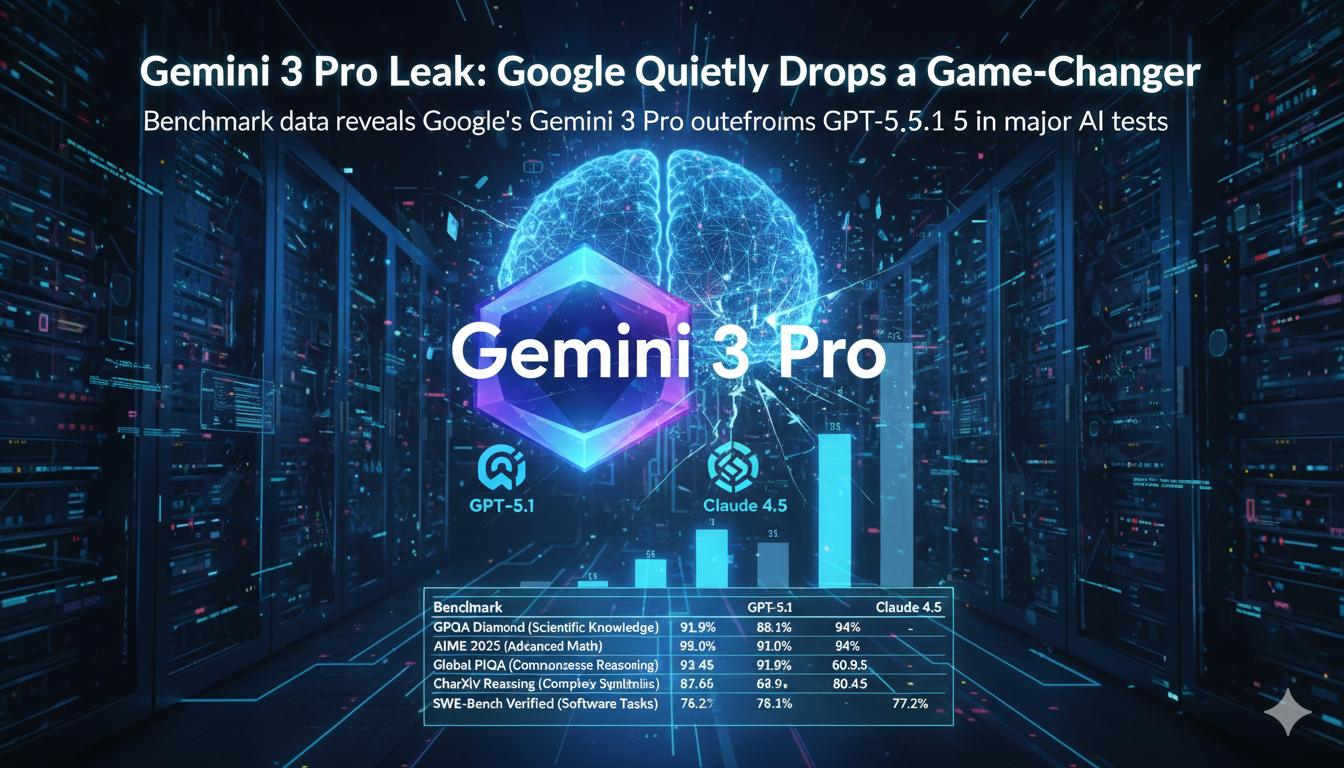Gemini 3 Pro Leak: Google Quietly Drops a Game-Changer

Google’s latest AI breakthrough, Gemini 3 Pro, has surfaced via a leaked model card—and it’s already making waves. Without a single press release, Google may have just leaped ahead in the AI arms race. The implications are enormous, not just for competition among tech giants, but for developers, researchers, and enterprises seeking to harness cutting-edge AI.
A Model Built to Dominate
According to a document published—then quickly removed—from DeepMind’s servers, Gemini 3 Pro represents a major architectural leap over previous models. It is a transformer-based sparse mixture-of-experts (MoE) system designed to handle complex tasks across modalities. Unlike its predecessors, it was built from scratch, not merely fine-tuned from existing architectures.
The model is natively multi modal, meaning it can simultaneously process and reason over text, images, video, and audio. This kind of integrated capability sets Gemini 3 Pro apart from other models still reliant on separate pathways or modules for each data type.
Some of the standout specifications include:
A 1 million token context window, enabling deep understanding of extremely long inputs such as books, research papers, or hours of video transcripts.
Support for outputs of up to 64,000 tokens, facilitating extended content generation and synthesis.
Trained using a diverse dataset that combines public web content, licensed data, user-product interaction data, and synthetic (AI-generated) examples.
Safety mechanisms such as robot.txt compliance, deduplication, and content filters to exclude harmful or low-quality material.
Training was executed using Google’s TPU v5e clusters via JAX and ML Pathways, ensuring a high degree of scalability and efficiency.
Benchmark Blowout: Outperforming the Titans
The most eye-catching part of the leak is the benchmark comparison. Gemini 3 Pro decisively beats leading models—OpenAI’s GPT-5.1 and Anthropic’s Claude 4.5—across a suite of demanding academic, reasoning, and vision-language tasks.
Inside the Training Data and Safety Strategy
The leaked model card offers rare insight into Google’s data pipeline. Training sources included:
Publicly available websites
Licensed data and academic corpora
Internal product interactions (e.g., Docs, Search, Gmail)
Synthetic data generated by previous AI models
Every dataset underwent multi-stage filtering for deduplication, explicit content, hate speech, misinformation, and legal constraints like CSAM. According to the document, Google also honored opt-outs and data usage restrictions.
Such measures reflect a growing focus on responsible AI—especially as regulators in the EU, US, and Asia increase scrutiny on data provenance and bias mitigation.
Where and How You Can Use It
Although the model has not been officially launched, the leak confirms several future access pathways for Gemini 3 Pro:
Gemini App (Google’s chatbot alternative to ChatGPT)
Google Cloud Vertex AI (enterprise AI deployment platform)
Gemini API (for developer integration)
Google AI Studio (experimental developer playground)
Antigravity (a rumored advanced compute interface for real-time agentic AI)
These distribution channels suggest that Google aims to tightly integrate Gemini 3 Pro across both consumer and enterprise platforms—similar to how OpenAI distributes GPT-4 Turbo via ChatGPT, API, and Azure.
Developer Reactions: Buzz Is Building
Since the model card leaked, Reddit, Hacker News, and developer Discords have lit up with speculation. Some early users—who appear to have accessed internal demos—report strong performance in:
Coding tasks with multi-file context
Synthesizing video + text for e-learning
Automated research assistants
Story generation with long-term character consistency
That said, some caution that performance under real-world latency constraints is still unproven.
What It Means for the AI Race
If these benchmarks hold up in public release, Gemini 3 Pro may set a new standard for general-purpose AI. Its long-context and multi modal performance could unlock use cases that current models still struggle with: e.g., analyzing legal contracts, generating rich multimedia narratives, or powering multimodal agents.
And for OpenAI, Meta, and Anthropic—the challenge is clear: either ship something better, or risk ceding ground to Google’s AI juggernaut.
Altacee will continue monitoring developments as Gemini 3 Pro becomes publicly available. In the meantime, developers can prepare by familiarizing themselves with Google’s Vertex AI tools and pre-registering for Gemini API access where possible.